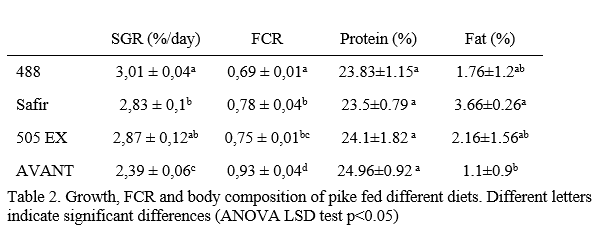Comparison of growth, survival and body composition of pike (Esox lucius) fingerlings using four different commercial feeds
Introduction
Pike (Esox lucius) is one of the most preferred fish by anglers worldwide and contributes to the ecological balance of freshwater ecosystems. The demand for pike fingerlings as stocking material could be supplied by aquaculture production. Previous studies have shown that rearing pike on a dry diet is possible (Kucska et al 2005, Szczepkowski 2006) but there is currently no adequate feed for pike on the market. As such feed developed for other species has to be used.
Materials and methods
In our experiment (lasting 71 days) four different commercial diets (produced by Aller Aqua, Poland) with different proximate composition were compared (Table 1.). 12 sets of 350 fish, (average weight of 3.01± 0.1 g) were distributed into 250L tanks and were fed by automatic feeders for 12h/day. The daily feed portions were determined as 3.5% of the biomass until day 24; 3% until day 42; 2% until day 58 and 1.5% until day 71 and were corrected by measuring the total weight of fish in each tank. At the end of the trial the weight and length of each fish was measured and 3 randomly chosen fish from each tank were sent for whole body composition analysis (crude fat, crude protein)
Results and conclusions
The best growth and feed conversion was observed on Aller 488 EX which contained the highest protein and lowest fat. These parameters declined as the protein levels decreased and the fat levels increased. Fish fed on Aller Safir had the highest fat content and fish fed on Aller Avant had the lowest fat content. No significant differences were observed in protein content (ANOVA LSD test p<0.05) (see Table 2).
Our study showed that the high protein and low fat commercial diets are the most adequate for rearing pike fingerlings. Quantifying the exact nutritional requirements for this species however, still remains to be done.
Acknowledgements
This work was financed by OTKA (PD-84289) Hungarian Scientific Research Fund.
References
Kucska, B., Müller, T., Sári, J., Bódis, M., Bercsényi, M. 2005. Successful growth of pike fingerlings (Esox lucius, L.) on pellet at artificial condition. Aquaculture 246: 227-230
Szczepkowski, M. 2006. The impact of water temperature on the growth and survival of juvenile Northern pike (Esox lucius L.) reared on formulated feed Archives of Polish Fisheries 14:85-93

